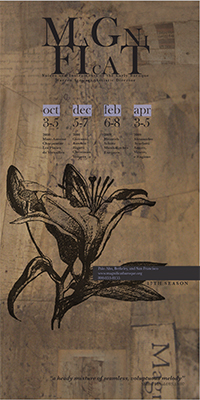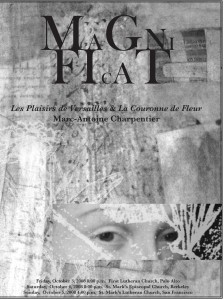2008-2009: Magnificat’s 17th Season
 Magnificat’s 16th season opened with two divertissements of Marc-Antoine Charpentier. In 1682, Charpentier’s patroness Madame de Guise commissioned entertainments for the coming winter season, when she would be in residence at Versailles. One of these court events was the “Fête of the Apartments”, an innovation by Louis XIV himself that began in November of that year and continued well into January. Three times a week, from 6 until 10 in the evening, a variety of entertainments were held in the principal rooms of the Great Apartment of Versailles: billiards, cards, games of chance, refreshments (including fruits, sorbets, wine and liqueurs, and hot coffee and chocolate), plus “symphonies” and “dancing”. Les Plaisirs de Versailles and La Couronne de Fleur were most probably performed on these occasions.
Magnificat’s 16th season opened with two divertissements of Marc-Antoine Charpentier. In 1682, Charpentier’s patroness Madame de Guise commissioned entertainments for the coming winter season, when she would be in residence at Versailles. One of these court events was the “Fête of the Apartments”, an innovation by Louis XIV himself that began in November of that year and continued well into January. Three times a week, from 6 until 10 in the evening, a variety of entertainments were held in the principal rooms of the Great Apartment of Versailles: billiards, cards, games of chance, refreshments (including fruits, sorbets, wine and liqueurs, and hot coffee and chocolate), plus “symphonies” and “dancing”. Les Plaisirs de Versailles and La Couronne de Fleur were most probably performed on these occasions.
In his review of the Berkeley performance, Joseph Sargent of the San Francisco Classical Voice wrote “Delivering a crystalline performance marked by luscious vocal purity and elegant instrumental support, Magnificat captured the vitality and freshness of these charming works, turning the evening into an impeccably refined affair.” Laura Heimes can be heard in an excerpt from Le Plaisirs de Versailles on Magnificat’s music page.
In December, Magnificat presented a Christmas Vespers drawing pslams and motets from the Messa e salmi concertate of 1639 by Giovanni Antonio Rigatti. Having sung as a boy under Monteverdi at San Marco in Venice, Rigatti held positions at several institutions in Northern Italy including one of the Ospedale in Venice. He returned to San Marco in 1647 shortly before his untimely death at the age of 35. The program also featured instrumental music by Massimiliano Neri, one of the organists at San Marco.
 In February, Magnificat performed Schütz’s Musikalische Exequien in a program that was similar to a program first performed at the 1996 Berkeley Festival and Exhibition but on a more intimate scale. The Exequien was commissioned for the funeral of Prince Heinrich Reuss Posthumus in 1635. In wishing to give this unqiue work a life beyond the specific occasion of its initial composition, he suggested in the preface of the publication that it could serve as a paraphrase of the Kyrie and Gloria in a amass for the Feast of Purification. Following the liturgical practice of the Dresden Court Chapel of the mid-1630s, and incorporating other music by Schütz and his collaegues, Magnificat’s program did just that.
In February, Magnificat performed Schütz’s Musikalische Exequien in a program that was similar to a program first performed at the 1996 Berkeley Festival and Exhibition but on a more intimate scale. The Exequien was commissioned for the funeral of Prince Heinrich Reuss Posthumus in 1635. In wishing to give this unqiue work a life beyond the specific occasion of its initial composition, he suggested in the preface of the publication that it could serve as a paraphrase of the Kyrie and Gloria in a amass for the Feast of Purification. Following the liturgical practice of the Dresden Court Chapel of the mid-1630s, and incorporating other music by Schütz and his collaegues, Magnificat’s program did just that.
As in other programs based on Lutheran liturgies, the audience was invited to join in for the congregational chorales. The program was framed by a Ricercar and Toccata by Johann Jakob Froberger played by Davitt Moroney.
Magnificat’s season concluded with Scarlatti’s serenata “Venere, Amore e Ragione” in performances that featured three “Jennifers”: Jennifer Ellis Kampani, Jennifer Paulino and Jennifer Lane. The precise circumstances of the first performance of Venere Amore, e Ragione are unknown, though it seems likely that the it was associated with Scarlatti’s induction in the Arcadian Academy in 1706. The libretto, attributed to the Roman poet Silvio Stampiglia -a fellow member of the Arcadian Academy who collaborated with Scarlatti on many occasions – recounts a dispute between Venus and Reason over the conduct of Venus’ son Cupid.
Over the course of the 2008-2009 season Artistic Director Warren Stewart directed ensembles that included Annette Bauer, Peter Becker, Louise Carslake, Daria D’Andrea, Hugh Davies, Rob Digins, John Dornenburg, Kristen Dubenion Smith, Jolianne von Einem, Paul Elliott, Jennifer Ellis Kampani, Ruth Escher, Elise Figa, Vicki Gunn Pich, Katherine Heater, Laura Heimes, Martin Hummel, Dan Hutchings, Jennifer Lane, Christopher LeCluyse, Craig Lemming, José Lemos, Davitt Moroney, Jennifer Paulino, Hanneke van Proosdij, David Tayler, and David Wilson.